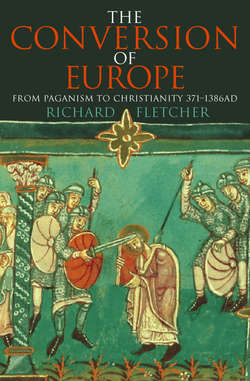The Conversion of Europe

Реклама. ООО «ЛитРес», ИНН: 7719571260.
Оглавление
Richard Fletcher. The Conversion of Europe
THE CONVERSION. OF EUROPE. From Paganism to Christianity. 371–1386 AD. RICHARD FLETCHER
DEDICATION
EPIGRAPH
CONTENTS
LIST OF MAPS
PREFACE
CHAPTER ONE. Who Is It For?
CHAPTER TWO. The Challenge of the Countryside
CHAPTER THREE. Beyond the Imperial Frontiers
CHAPTER FOUR. The New Constantines
CHAPTER FIVE. An Abundance of Distinguished Patrimonies
CHAPTER SIX. The Chalice and the Horn
CHAPTER SEVEN. Campaigning Sceptres: the Frankish Drive to the East
CHAPTER EIGHT. Rising by Steps: Christian Consolidation
CHAPTER NINE. Rival Monotheisms
CHAPTER TEN. A Certain Greek Named Methodius
CHAPTER ELEVEN. Scandinavians Abroad and at Home
CHAPTER TWELVE. The Eastern Marches from Wenceslas to Nyklot
CHAPTER THIRTEEN. Mission into Church
CHAPTER FOURTEEN. The Sword Our Pope: the Baltic and Beyond
CHAPTER FIFTEEN. Slouching Towards Bethlehem
FURTHER READING. CHAPTER 1
CHAPTER 2
CHAPTER 3
CHAPTER 4
CHAPTER 5
CHAPTER 6
CHAPTER 7
CHAPTER 8
CHAPTER 9
CHAPTER 10
CHAPTER 11
CHAPTER 12
CHAPTER 13
CHAPTER 14
Praise
INDEX
NOTES. ABBREVIATIONS USED IN THE NOTES
CHAPTER 1
CHAPTER 2
CHAPTER 3
CHAPTER 4
CHAPTER 5
CHAPTER 6
CHAPTER 7
CHAPTER 8
CHAPTER 9
CHAPTER 10
CHAPTER 11
CHAPTER 12
CHAPTER 13
CHAPTER 14
CHAPTER 15
COPYRIGHT
ABOUT THE PUBLISHER
Отрывок из книги
To my Father
in memory of my Mother
.....
Crippled by instability, civil war, fiscal chaos – and, just to make matters worse, by intermittent outbreaks of bubonic plague – the empire was in no position to defend its frontiers. From 224 onwards the new Persian dynasty of the Sassanids constituted a well-organized and hostile presence to the east, bent upon regaining the Syrian territories which Persian kings of old had ruled. For the Roman empire, the most humiliating moment of this time of troubles occurred in 260 when the Emperor Valerian was captured by the Persians. The Germanic tribes of the Goths, settled at this period on the northern shores of the Black Sea in today’s Ukraine, took to the sea to strike deep into Asia Minor. By land, they pressed hard on the Danube frontier, launching raids into the Balkans and Greece. The Emperor Decius was defeated and killed by them in Thrace in the year 251. Along the Rhine frontier new Germanic confederations, those of the Alamans and of the Franks, took shape. In 257 they broke into Gaul to plunder it at will. Some of them even penetrated as far as northeastern Spain, where they sacked the city of Tarraco (Tarragona). Berbers along the Saharan fringes attacked the long, thin, vulnerable littoral of Roman north Africa. In far-flung Britain the construction of coastal defences witnessed to new enemies from overseas – Saxons from Germany and Scots from Ireland. One of the most telling signs of the times was the building of town walls throughout the western provinces of Gaul, Spain and Britain, furnishing defences for settlements which had never needed them before.
The third-century slide into anarchy and helplessness was arrested by the Emperor Diocletian (284–305). His stabilizing reforms, fiscal, military and bureaucratic, were continued and extended under his successor Constantine I (306–37). Their work gave the empire the stamina and solidity it enjoyed in the fourth century. One feature of these reforms was the adoption of ideas about monarchy, together with the associated ceremonies and ritual, which drew on earlier Hellenistic and Persian thinking. The principal tendency of this body of political theory was to stress the power of the ruler in matters sacred as well as profane. It would encourage the moving together of church and state and, as time went by, their near merging in the imperial theocracies of the East Roman or Byzantine empire and, much later, in its Russian heir. It was a tendency which was less pronounced in the western provinces of the fourth-century empire. This was a difference which had important implications, to which we shall return shortly. A second feature was the division of the unitary empire into two halves, an eastern and a western. Diocletian had led the way here, dividing the empire into a tetrarchy – a senior emperor in east and west, each with a subordinate emperor – as part of his reforms; a decentralization intended to make more effective the emperors’ discharge of their primary responsibility, defence. This formal structure was not maintained after his death and practice varied in the course of the fourth century, but by its last quarter the political division into eastern and western empires had become permanent. One development which helped to institutionalize it was Constantine’s foundation of a new capital city in the east, named after him – Constantinople.
.....